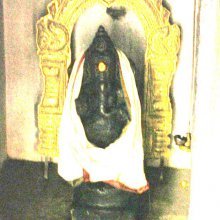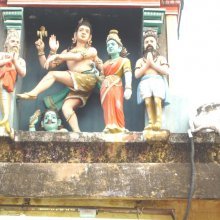Nirutti: 5 definitions
Introduction:
Nirutti means something in Buddhism, Pali, Jainism, Prakrit, Tamil. If you want to know the exact meaning, history, etymology or English translation of this term then check out the descriptions on this page. Add your comment or reference to a book if you want to contribute to this summary article.
Images (photo gallery)
In Buddhism
Theravada (major branch of Buddhism)
Source: Pali Kanon: Pali Proper NamesA work on exegesis, ascribed to Maha Kaccayana and divided into two parts: Culanirutti and Mahanirutti (Gv.59, 65; Svd.1233f). Atika on it exists, the Niruttisaramanjusa, written by Saddhammaguru. Bode, p.29; Gv.60.
Theravāda is a major branch of Buddhism having the the Pali canon (tipitaka) as their canonical literature, which includes the vinaya-pitaka (monastic rules), the sutta-pitaka (Buddhist sermons) and the abhidhamma-pitaka (philosophy and psychology).
Languages of India and abroad
Pali-English dictionary
Source: BuddhaSasana: Concise Pali-English Dictionarynirutti : (f.) language; philology.
Source: Sutta: The Pali Text Society's Pali-English DictionaryNirutti, (f.) (Sk. nirukti, nis+vac) one of the Vedāṅgas (see chaḷaṅga), explanation of words, grammatical analysis, etymological interpretation; pronunciation, dialect, way of speaking, expression Vin. II, 139 (pabbajitā ... sakāya niruttiyā Buddhavacanaṃ dūsenti); D. I, 202 (loka°, expression); M. III, 237 (janapada°); S. III, 71 (tayo n-pathā); A. II, 160 (°paṭisambhidā); III, 201; Dh. 352 (°padakovida=niruttiyañ ca sesapadesu cā ti catūsu pi paṭisambhidāsu cheko ti attho DhA. IV, 70; i.e. skilled in the dialect or the original language of the holy Scriptures); Ps. I, 88 sq.; II, 150 (°paṭisambhidā); Nd2 563; Dhs. 1307; Nett 4, 8, 33, 105; Miln. 22; Vism. 441; SnA 358; PvA. 97. (Page 370)

Pali is the language of the Tipiṭaka, which is the sacred canon of Theravāda Buddhism and contains much of the Buddha’s speech. Closeley related to Sanskrit, both languages are used interchangeably between religions.
Prakrit-English dictionary
Source: DDSA: Paia-sadda-mahannavo; a comprehensive Prakrit Hindi dictionaryṆirutti (णिरुत्ति) in the Prakrit language is related to the Sanskrit word: Nirukti.
Prakrit is an ancient language closely associated with both Pali and Sanskrit. Jain literature is often composed in this language or sub-dialects, such as the Agamas and their commentaries which are written in Ardhamagadhi and Maharashtri Prakrit. The earliest extant texts can be dated to as early as the 4th century BCE although core portions might be older.
Tamil dictionary
Source: DDSA: University of Madras: Tamil LexiconNirutti (நிருத்தி) noun < nir-ukti. Etymological interpretation of a word; சொற்கு உறுப்புப் பொருள் கூறுகை. அழியா நிருத்தி [sorku uruppup porul kurugai. azhiya niruthi] (பிரயோகவிவேகம் [pirayogavivegam] 50).
Tamil is an ancient language of India from the Dravidian family spoken by roughly 250 million people mainly in southern India and Sri Lanka.
See also (Relevant definitions)
Starts with: Nirutti Patisambhida, Niruttia, Niruttikkol, Niruttipatha Sutta, Niruttipatisambhida, Niruttippiti, Niruttisaramanjusa, Niruttiya, Niruttiyalankaram, Niruttiyelutu.
Ends with: Mahanirutti.
Full-text (+16): Nirukti, Niruvacanam, Niruttiyalankaram, Mottaikkopuram, Ten-merricaipalan, Verin, Tatuttuvai, Niruttisaramanjusa, Vibhatti Sutta, Nerutta, Nirutiticai, Marutanam, Iluttuppecu, Pallavotam, Unrippati, Nisanti Sutta, Tatankalpannu, Nilal-kanmantilam, Sakkharappabheda, Ashta-tikkupalakar.
Relevant text
Search found 14 books and stories containing Nirutti, Ṇirutti, Niruthi; (plurals include: Niruttis, Ṇiruttis, Niruthis). You can also click to the full overview containing English textual excerpts. Below are direct links for the most relevant articles:
The Great Chronicle of Buddhas (by Ven. Mingun Sayadaw)
Part 12 - The Four Kinds of Analytical Knowledge (Paṭisambhidā-ñāṇa) < [Chapter 42 - The Dhamma Ratanā]
Part 5 - Māra’s Threat to Rāhula < [Chapter 32b - The Buddha’s Fourteenth Vassa at Savatthi]
Part 2 - Bodhisatta (a future Buddha) < [Chapter 2 - Rare Appearance of a Buddha]
Middle Chola Temples (by S. R. Balasubrahmanyam)
Mahamandapa and Mukhamandapa < [Tanjavur/Thanjavur (Rajarajesvaram temple)]
Temples in Gangaikondasolapuram (Gangaikondacholapuram) < [Chapter IV - Temples of Rajendra I’s Time]
Vinaya Pitaka (4): Parivara (by I. B. Horner)
Upāli-Pentads (Division 8: Exhortation of Nuns) < [17. Upāli-Pentads]
The Jataka tales [English], Volume 1-6 (by Robert Chalmers)
Jataka 478: Dūta-jātaka < [Volume 4]
The Life of Sariputta (by Nyanaponika Thera)
The Turner Of The Wheel < [Part II - Maturity Of Insight]
Mahavamsa (by Wilhelm Geiger)

